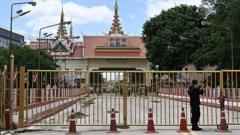Rapid mining of rare earth minerals in conflict zones of Myanmar, driven by Chinese enterprises, is causing severe environmental degradation in Thailand, raising concerns over rising toxic metal levels in waterways and potential health risks for residents.**
Environmental Fallout: Myanmar's Rare Earth Mining Crisis Affects Thailand's Waterways**

Environmental Fallout: Myanmar's Rare Earth Mining Crisis Affects Thailand's Waterways**
Unregulated mining activities in Myanmar are leading to toxic pollution in Thai rivers, with alarming health consequences for local communities.**
---
In recent years, unregulated mining of rare earth minerals in Myanmar has sparked an environmental disaster spilling into Thailand, with rivers now carrying dangerous levels of toxins. This situation has severely impacted local ecosystems and poses significant health risks for communities dependent on these waterways.
Once pristine, the Kok River, a tributary of the Mekong, now flows with sediment and pollutants stirred by mining operations across the border. Recent government data highlights alarming spikes in arsenic and other toxic metals in the river, where many villagers used to fish and bathe. Residents have reported skin ailments, and fears are growing regarding potential long-term health consequences, including various cancers linked to this pollution.
As rare earth demand grows globally, a handful of mines have emerged alongside the Kok River. These activities are primarily owned and operated by Chinese enterprises, presenting a challenge for local governance in Myanmar. Villagers in regions like Thaton have voiced concerns that increasing pollution levels are linked to their deteriorating health and livelihoods.
Images from recent satellite analyses reveal that over 300 mines have developed near the Myanmar-China border, exacerbating the environmental crisis. The pollution does not end at national borders; it travels downstream, entering waterways vital to communities across Southeast Asia.
This clash of resource extraction and environmental integrity raises ethical questions about the usage of these minerals and the shared responsibility of nations in mitigating pollution and protecting residents from harmful industrial practices. The sustainability of the region's ecosystems hangs perilously in the balance as tensions rise between economic interests and the health of local populations.
In recent years, unregulated mining of rare earth minerals in Myanmar has sparked an environmental disaster spilling into Thailand, with rivers now carrying dangerous levels of toxins. This situation has severely impacted local ecosystems and poses significant health risks for communities dependent on these waterways.
Once pristine, the Kok River, a tributary of the Mekong, now flows with sediment and pollutants stirred by mining operations across the border. Recent government data highlights alarming spikes in arsenic and other toxic metals in the river, where many villagers used to fish and bathe. Residents have reported skin ailments, and fears are growing regarding potential long-term health consequences, including various cancers linked to this pollution.
As rare earth demand grows globally, a handful of mines have emerged alongside the Kok River. These activities are primarily owned and operated by Chinese enterprises, presenting a challenge for local governance in Myanmar. Villagers in regions like Thaton have voiced concerns that increasing pollution levels are linked to their deteriorating health and livelihoods.
Images from recent satellite analyses reveal that over 300 mines have developed near the Myanmar-China border, exacerbating the environmental crisis. The pollution does not end at national borders; it travels downstream, entering waterways vital to communities across Southeast Asia.
This clash of resource extraction and environmental integrity raises ethical questions about the usage of these minerals and the shared responsibility of nations in mitigating pollution and protecting residents from harmful industrial practices. The sustainability of the region's ecosystems hangs perilously in the balance as tensions rise between economic interests and the health of local populations.





















